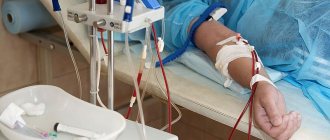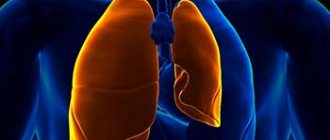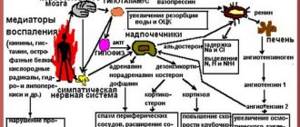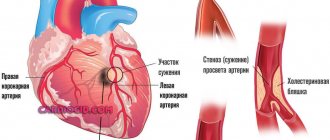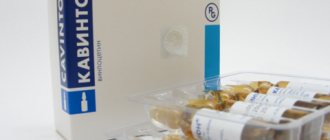Fainting, collapse: causes of development, diagnostic algorithm, emergency care.
In the pathogenesis of acute vascular insufficiency, the discrepancy between the capacity of the vessels and the amount of blood circulating in them is of decisive importance.
Most often, loss of tone and vasodilation are observed in the abdominal organs. Stagnation of blood in them leads to the exclusion of a large amount of blood from the circulation. Due to a decrease in circulating blood volume, there is insufficient blood supply to the brain and other organs. On the other hand, a decrease in circulating blood volume is observed with blood loss, injury, shock, and dehydration. Acute vascular insufficiency can clinically manifest itself in the form of fainting, collapse and shock. The causes may be intoxication, hyperthermia, mental and physical trauma, surgery, especially with large blood loss, etc. Fainting (syncope)
– short-term loss of consciousness developing as a result of acute cerebral ischemia. It is more often observed in girls during puberty, as well as in emotionally labile children, in whom blood redistribution easily occurs reflexively under the influence of various psychogenic influences.
Fainting clinic.
A sudden feeling of weakness, darkening of the eyes, tinnitus, dizziness, nausea, and sometimes vomiting appears. Then comes a short-term loss of consciousness. Blood pressure drops sharply - 50 - 60 mm Hg. Art. The pupils are constricted, the pulse is slow (40–50 per minute) or accelerated, heart sounds are muffled. Breathing is rare, shallow (sometimes deep). Severe pallor of the skin and mucous membranes. Profuse sweat. The duration of the attack is from several seconds to 1 minute.
First aid for fainting.
The patient must be placed in a horizontal position with the head end of the bed slightly lowered or with the lower limbs raised, ensure a sufficient flow of fresh air, unbutton (tear) tight clothing, sprinkle cold water on the chest and face, and warm the limbs (a heating pad). Inhalation of ammonia solution vapors is effective. This is usually enough to return consciousness and improve the condition. In more severe cases, inject intramuscularly 1 ml of a 10% solution of Caffeine or 2 ml of Cordiamin. Until consciousness is restored, blood circulation and breathing are normalized, the patient should be treated on the spot. Then, if necessary, place in a hospital to exclude any diseases of the internal organs and internal bleeding.
Collapse
– acute vascular insufficiency, resulting from a violation of the regulatory function of the vasomotor center, a sharp decrease in vascular tone (dilation and paresis), especially in the abdominal organs. This leads to accumulation of blood in the abdominal organs and cerebral ischemia.
Etiology of collapse.
The causes of collapse are severe acute infectious diseases, intoxication, blood loss, dehydration, damage to the adrenal glands, severe injuries, acute myocarditis. In this case, in contrast to fainting, not only functional, but also organic changes in the vessels are observed with an increase in the permeability of their walls and the release of plasma from the bloodstream. In the pathogenesis of collapse, the main significance is a decrease in the amount of circulating blood and cardiac output, and a decrease in blood pressure. Brain hypoxia develops, the function of the central nervous system, liver, kidneys and cardiovascular system is disrupted (secondary heart failure), azotemia and acidosis are noted.
Collapse Clinic.
The patient is initially restless, the skin is pale with a cyanotic tint (“marble”). Body temperature is reduced, tissue turgor is low, breathing is shallow and rapid. Then anxiety gives way to depression, the patient is lethargic, complains of weakness, chilliness, and thirst. Acrocyanosis, cold clammy sweat. Pulse – irregular, frequent, small filling. Subsequently, the patient is apathetic, motionless, facial features are sharpened, eyes are sunken; the pupils are dilated, weakly responsive to light, the muscles are relaxed. Blood pressure drops. The liver may be enlarged and tender to palpation. Frequent vomiting is often observed. Diuresis decreases. Consciousness is usually preserved. In all cases of collapse, a differential diagnosis should be made with heart failure due to different treatment tactics for these conditions. Depending on the pathogenesis and clinical manifestations, three types of collapse are currently distinguished: sympathotonic, vagotonic and paralytic.
Sympathotonic collapse
accompanied by a predominance of the tone of the sympathetic nervous system, which leads to spasm of the arterioles of internal organs, muscles, and skin. Blood accumulates in the heart and large vessels (centralization of blood circulation). Causes: blood loss, neurotoxicosis, acute dehydration. There is normal or increased systolic pressure with high diastolic and, therefore, sharply reduced pulse pressure.
Vagotonic collapse
develops against the background of predominance of the tone of the parasympathetic nervous system. There is an expansion of arterioles and arteriovenous anastomoses, in which blood accumulates during cerebral ischemia. Bradycardia, decreased diastolic and increased pulse pressure are observed. Causes: fainting, fear, hypoglycemic coma, anaphylactic shock, severe infections with damage to the adrenal glands.
Paralytic collapse
develops when the mechanisms regulating blood circulation are depleted. As a result, passive dilatation of blood vessels occurs, where blood is deposited, and cerebral ischemia. Causes: dehydration, neurotoxicosis, diabetic coma, severe intoxication, severe damage to the adrenal glands. Blood pressure (maximum and minimum) is sharply reduced.
Causes of collapse
Regulation of vascular tone is carried out using three mechanisms: local, humoral and nervous. The nervous mechanism consists of stimulation of the vessel wall by fibers of the sympathetic and parasympathetic nervous system. The humoral method is realized due to sodium and calcium ions, vasopressor hormones (adrenaline, vasopressin, aldosterone). Local regulation involves the appearance of foci of ectopia directly in the vascular wall, the cells of which have the ability to generate their own electrical impulses. The circulatory network of skeletal muscles is regulated primarily by the nervous system, so collapse can be caused by any conditions in which the activity of the vasomotor center of the brain is suppressed. The main etiofactors are:
- Infectious processes . Severe infections accompanied by severe intoxication lead to the development of vascular insufficiency. Most often, collapse occurs with lobar pneumonia, sepsis, peritonitis, meningitis and meningoencephalitis, typhoid fever, focal inflammatory diseases of the central nervous system (brain abscess).
- Exogenous intoxications. Pathology is detected in case of poisoning with organophosphorus compounds, carbon monoxide, and drugs that can affect vascular tone (clonidine, capoten, ebrantil). In addition, collapse can develop under the influence of local anesthetic drugs when administered epidurally or peridurally.
- Heart diseases. The most common cause is acute myocardial infarction. Collaptoid conditions can also be detected against the background of cardiac malformations, decreased myocardial contractility, tachy- or bradyarrhythmia, dysfunction of the sinoatrial node (pacemaker), failure of the atrioventricular connection (3rd degree AV block) with discoordination of the atria and ventricles.
- Injuries. The main cause of vascular insufficiency in trauma is a large volume of blood loss. In this case, there is not a relative, but an actual decrease in BCC due to physical loss of fluid. In the absence of profuse hemorrhage, a drop in vascular tone becomes a reaction to severe pain, which is more common in children and patients with high tactile sensitivity.
What is collapse
In many diseases, a disruption may occur in the functioning of the autonomic nervous system, which is responsible for regulating vascular tone. In such situations, acute vascular insufficiency may develop.
During collapse, pressure drops as paresis of small vessels occurs. The volume of blood moving through them decreases sharply, and blood flow slows down. This leads to the fact that the brain ceases to receive the necessary amount of oxygen and nutrients. The same goes for the heart muscle.
In this condition, blood supply throughout the body is disrupted, which leads to metabolic disorders. Not only neuro-reflex disorders can lead to vascular insufficiency, but also toxic substances of a protein nature. This usually happens during infectious diseases, such as pneumonia, typhus, during a heart attack or severe blood loss.
Symptoms
The clinical picture of orthostatic collapse can be different, and depending on the severity of its symptoms, three degrees of severity of this condition are distinguished:
- I (mild) – rare pre-syncope without loss of consciousness;
- II (moderate) – the appearance of episodic fainting during prolonged standing in a motionless position or after transferring the body to a vertical position;
- III (severe) – frequent fainting, which occurs even in a half-sitting or sitting position or after a short period of standing in a motionless position.
Episodes of orthostatic hypotension in most patients proceed in the same way. Immediately after transferring the body to a vertical position or during a long stay in a standing position, the patient develops the following symptoms:
- sudden and increasing general weakness;
- “fog” or “clouding” before the eyes;
- dizziness, accompanied by sensations of “falling through”, “premonition of fainting”, “falling in the elevator” or “loss of support”;
- palpitations (in some cases).
If orthostatic collapse is caused by prolonged and immobile standing, patients often report the following sensations:
- perspiration on the face;
- chilliness;
- "lightheadedness";
- nausea.
The clinical picture of mild orthostatic hypotension is limited only by these symptoms. They usually resolve on their own after straight-legged heel-to-toe walking, walking, or performing exercises to tense the muscles of the legs, thighs, and abdominals.
With moderate orthostatic hypotension, if the patient does not have time to lie down with his legs raised, the above symptoms culminate in fainting, during which involuntary urination may occur. Before loss of consciousness, which lasts no more than a few seconds, the patient experiences the following changes in state:
- increasing pallor;
- dampness of palms;
- coldness of hands and feet;
- cold sweat on the face and neck.
In moderate orthostatic hypotension, two types of changes in blood pressure and pulse are observed:
- thread-like pulse and increasing bradycardia, accompanied by a decrease in systolic and diastolic pressure;
- pronounced tachycardia, accompanied by a decrease in systolic and an increase in diastolic pressure.
Mild and moderate degrees of orthostatic collapse develop gradually: in about a few seconds. In most cases, the patient manages to take some measures in order to smooth out the fall: he bends his knees (as if squatting on the floor), manages to put his hand forward, etc.
With severe orthostatic hypotension, fainting is accompanied by convulsions, involuntary urination and becomes more sudden and prolonged (up to 5 minutes). The patient suddenly falls without any changes in movements. Falls can lead to a variety of injuries. In such patients, episodes of orthostatic collapse may occur over a long period of time (months or years), and this causes changes in gait. They walk with sweeping steps, with their knees bent and their heads hanging low.
According to the duration of the periods in which episodes of orthostatic collapse are observed, they are divided into:
- subacute - several days or weeks (characteristic of orthostatic hypotension caused by transient disturbances in the functioning of the autonomic nervous system due to infectious diseases, intoxication or taking medications);
- chronic – more than a month (characteristic of pathologies of the cardiovascular, nervous or endocrine systems);
- chronic progressive - for years (characteristic of idiopathic orthostatic hypotension).
Types of collapse
Depending on the clinic and pathogenesis, collapse is divided into three types:
- Sympathotonic. This form of collapse is accompanied by increased tone of the sympathetic nervous system, which leads to spasm of the arteries throughout the body. Systolic pressure in such situations is normal or slightly elevated, and diastolic pressure is high. If such a collapse is observed, emergency care is required urgently so as not to develop more serious complications.
- Vagotonic collapse. In this state, the parasympathetic system comes into tone. The arteries, on the contrary, dilate, diastolic pressure decreases, and bradycardia is observed. The cause of this condition is fear, fainting, hypoglycemic coma.
- Paralytic. Most often it happens when the mechanisms that are responsible for regulating blood circulation are severely depleted. The vessels dilate, the pressure drops, and collapse occurs; emergency care comes down to normalizing, first of all, blood pressure.
Mechanism of collapse development
With a sudden change in the position of a person’s body from horizontal to vertical or when standing for a long time in one position, venous blood, under the force of its own gravity, descends to the lower extremities and flows in a smaller volume to the heart muscle. A decrease in the volume of blood entering the heart leads to a sharp decrease in blood pressure and brain hypoxia, which leads to the development of presyncope or fainting.
Fainting
Orthostatic hypotension can occur in people of different ages and under the influence of various factors - from diseases of internal organs and systems to situational reasons. In this article you will find complete information on how to recognize an incipient collapse and prevent the development of fainting, as well as how to provide first aid to a person who has suffered vascular collapse and lost consciousness.
Signs of collapse
As a rule, recognizing collapse is not difficult. Its manifestations are usually clear and bright, so it is almost impossible to confuse it with other diseases. The main symptoms of collapse include the following:
- A sharp deterioration in a person's condition.
- Severe and sudden headache.
- Noise in ears.
- It gets dark in my eyes.
- Weakness in the body.
- Unpleasant sensations appear in the heart.
- A sharp decrease in pressure.
- The skin turns pale and cold sweat appears.
- A bluish tint appears in the nails, skin on the hands and feet.
- Facial features become sharper.
- Breathing becomes frequent and shallow.
- Body temperature decreases.
- The pulse is thread-like and difficult to palpate.
- Loss of consciousness often occurs.
Providing emergency assistance in case of collapse should be carried out immediately in order to bring the person out of this state as quickly as possible.
Causes
If a person often experiences dizziness when changing body position, and sometimes severe weakness, even fainting, then it is necessary to consult a doctor to find out the cause of this condition.
The main reasons for the development of orthostatic collapse are:
- oxygen starvation of the brain;
- untimely reaction of the heart and blood vessels to changes in body position;
- a sharp decrease in blood pressure.
Such changes in the functioning of the body can be caused by many factors. Orthostatic hypotension is sometimes observed in healthy people. A sudden rise from bed after sleep (especially if the person is not fully awake), prolonged and motionless standing, prolonged space flights - such events can lead to a sharp decrease in blood pressure and cause pre-syncope or fainting of varying severity in people who do not suffer from heart disease , blood vessels or endocrine and nervous systems. In other cases, the orthostatic reaction is provoked by pathologies or adverse effects of various factors.
Orthostatic collapse can be caused by the following disorders:
- primary neuropathies: Bradbury-Eggleston syndrome, Shy-Drager syndrome, Riley-Day syndrome, Parkinson's disease;
- secondary neuropathies: autoimmune diseases, diabetes mellitus, post-infectious polyneuropathy, amyloidosis, alcoholism, porphyria, syringomyelia, paraneoplastic syndromes, tabes dorsalis, pernicious anemia, vitamin deficiencies, conditions after sympathectomy;
- idiopathic factors, i.e. unknown causes;
- taking medications: diuretics, calcium antagonists, nitrates, angiotensin inhibitors, dopaminergic drugs (used for hyperprolactinemia or Parkinson's disease), some antidepressants, barbiturates, Vincristine, Quinidine, etc.;
- severe varicose veins;
- myocardial infarction;
- TELA;
- severe cardiomyopathy;
- aortic stenosis;
- heart failure;
- constrictive pericarditis;
- cardiac tamponade;
- bleeding;
- infectious diseases;
- anemia;
- disturbances in water and electrolyte balance leading to dehydration;
- pheochromocytosis;
- adrenal insufficiency;
- long bed rest;
- primary hyperaldosteronism;
- binge eating.
Orthostatic collapse can be one of the signs of many cardiac pathologies. Its sudden appearance may indicate unrecognized arrhythmias, pulmonary embolism or myocardial infarction, and in aortic stenosis, constrictive pericarditis and severe cardiomyopathy, orthostatic hypotension appears only with a rapid transfer of the body to an upright position.
Symptoms of collapse in children
The child’s body is much more sensitive to any malfunction in its functioning, so the onset of collapse can be accurately recorded. The symptoms are usually the following:
- The child suddenly becomes ill.
- He is lethargic, he is not interested in the world around him.
- The skin becomes pale and covered in cold sweat.
- Cyanosis of the lips is observed.
- A thread-like pulse is barely palpable.
- Usually tachycardia, but bradycardia may also occur.
- Blood pressure drops sharply.
- Babies may experience convulsions due to hypoxia.
In such situations, emergency assistance for collapse in children is urgently required.
First aid for collapse
It may happen that your loved one needs help with collapse. No one is immune from this, so every person should have basic skills in providing it. The algorithm for providing emergency care during collapse, although voluminous, is quite easy for anyone to remember.
- Call an ambulance.
- In the event of such an attack, the patient must be placed on his back on a flat surface.
- Unfasten the top buttons on the clothing, if any.
- It is advisable to open the window in the room to allow more fresh air to enter.
- The legs can be raised slightly to increase blood flow to the head.
- Since there is a decrease in body temperature, the patient must be warmed with a heating pad.
- Place a swab soaked in ammonia to your nose.
- Introduce 0.1% solution of “Adrenaline”, 0.5% solution of “Ephedrine”.
- If the collapse is caused by severe bleeding, then it must be stopped.
- Provide the patient with complete rest.
- In case of cardiac arrest, it is necessary to perform chest compressions in combination with artificial respiration.
We looked at what constitutes collapse. Emergency assistance, the algorithm for its implementation - these issues were also touched upon by us, but there are other points that must be taken into account.
Prohibited during collapse
If you need to provide first aid to a person in case of collapse, this does not mean that all means are good. There are things you shouldn't do:
- Under no circumstances should a patient be given heart medications, as they dilate blood vessels.
- During loss of consciousness, you should not try to pour a little water into your mouth or stuff a pill.
- It is also not recommended to resort to slapping to bring a person to his senses.
Most often, minutes count in such situations, so even before the ambulance arrives, competent emergency care should be provided for fainting and collapse.
Drug therapy during collapse
The ambulance that arrives will certainly take the patient to the hospital. Help will be provided within its walls, but with the use of medications. First of all, intravenous infusions of sodium chloride are prescribed. The amount of the drug is determined according to the patient's condition. The doctor pays attention to the following signs:
- The human condition and the totality of all indicators.
- Color of the nasolabial triangle: if it is too pale, then more vasodilator will be needed.
- Diuresis.
- The value of blood pressure.
- Heart rate.
As additional therapy the following is prescribed:
- Anti-inflammatory drugs, for example, Metipred, Prednisolone.
- Vasopressor drugs are administered intravenously.
- To quickly relieve spasms, Novocaine is administered.
After the patient’s condition returns to normal, treatment of the disease that provoked the collapse begins. You must always remember: if your loved one collapses, the emergency care you provide can save a life. That is why everyone should know the list of necessary actions during such a situation. Health to everyone, may such situations never happen in your life.
What is collapse?
In a simplified view, collapse is fainting. There is a sharp change in body position, during which the pressure drops to critical levels. This is an acute form of vascular insufficiency. A condition characterized by a decrease in vascular tone and, as a result, a significant deterioration in the functioning of the circulatory system.
If you provide emergency first aid in case of collapse, you can avoid unpleasant complications or save the life of the victim. With heart failure, blood flow decreases, internal organs do not receive enough nutrition, brain activity deteriorates and asphyxia develops. Prolonged stay in this state in the absence of help threatens the suppression of vital functions.
Causes
Collapse can occur due to sudden blood loss during injury. In addition, cardiac dysfunction develops if the body is faced with negative environmental factors (toxic effects, infections, etc.). There are certain risk factors that increase the risk of acute respiratory failure. Reasons contributing to this include:
- bleeding (both internal and external);
- a significant increase in the dose of certain drugs (neuroleptics, adrenergic blockers, etc.);
- entry of toxic substances into the body, severe intoxication;
- infectious collapse develops against the background of previous infections (typhoid, pneumonia, etc.);
- insufficient oxygen content in the room;
- acute pathologies of the pancreas;
- excessive overheating, as well as dehydration;
- electric shock;
- hormonal changes in the body during adolescence (often found in girls);
- pathological heart diseases.
In order to properly provide first aid in case of collapse, you will need to know what risk factor triggered the exacerbation of the condition.
Types of collapse
In medicine, there are conventionally three types of collapse:
- Hypovolemic;
- Cardiogenic;
- Vasodilatory.
The occurrence of hypovolemic collapse is caused by dehydration of the body, severe blood loss or plasma loss, due to which the volume of blood in the vessels sharply decreases.
Cardiogenic collapse occurs against the background of:
- Heart failure;
- Acute cardiac dysfunction;
- A sharp decrease in cardiac output.
Vasolidation collapse is characteristic of severe infectious and toxic conditions, deep hypoxia, hyperthermia, hypocapnia, endocrinopathy, and develops with improper use of medications and with an excess of kinins, histamine and adenosine in the blood, leading to general peripheral vascular resistance.
Manifestation mechanism
Deterioration in health in most cases develops suddenly, so it comes as a surprise to the victim. He may remain conscious, but will not react to what is happening.
In this pathological condition, the pressure is as low as possible, but the manifestations may vary slightly. It depends on what type of collapse it is.
It is important to determine the type of lesion as it may affect care and further treatment:
- infectious. Appears against the background of previous severe infections;
- toxic. Associated with exposure to toxins. Often develops in those who work in production;
- burn type of heart failure. Etymology and pathogenesis relate to severe thermal damage to the skin;
- hypoxemic. This variety is associated with changes in pressure outside, to which weather-dependent people react;
- pancreatic. Occurs with pathologies of the pancreas;
- hyperthermic. Formed during heat stroke;
- dehydration Associated with dehydration;
- cordial. The reason for the appearance is the presence of pathologies of the cardiovascular system;
- orthostatic. Appears with a sudden change in body position in patients who cannot walk independently;
- hemorrhagic. Develops against the background of severe blood loss.
Prevention
There are practically no methods for preventing collapse. You can only prevent the state of massive blood loss. Or a state of stress. As well as intoxication, ischemia, infectious diseases.
Infectious diseases must be treated promptly. This helps prevent conditions such as collapse. It is also important to prevent damage to the cardiovascular system.
In this case, it is necessary to see doctors more often. Especially if there are abnormalities in cardiac activity. Extensive intoxication also contributes to the development of this condition.
To prevent intoxication, it is necessary not to self-medicate, take medications only as indicated, and treat various infections in a timely manner.
In preventing collapse, it is important to prevent stress. This refers to a strong emotional shock. Only certain sedatives will help you cope with stress.
If there is a serious endocrine pathology, then it is necessary to take hormonal drugs. Hormone therapy is aimed at replacing necessary hormones. This means necessary therapy for this condition.
If there is a toxic factor. For example, in case of poisoning. Necessary measures should be taken immediately. Treat this condition. Otherwise, severe poisoning will lead to the development of collapse.
go to top
Symptoms of collapse
Help with collapse should be provided when the first symptoms appear. Even while conscious, a person is not able to adequately respond to others. Fainting is accompanied by the following symptoms:
- extremely pale skin tone, tinged blue in places;
- deterioration of health, tinnitus, darkness in the eyes;
- dry mucous membranes;
- decreased body temperature, chills;
- breathing is rapid or, on the contrary, slow, shortness of breath appears;
- the pulse is difficult to detect, it is slow, and may be completely absent;
- a sharp decrease in blood pressure to minimum values;
- discomfort in the heart area, headache;
- nausea and vomiting.
With collapse, facial features become sharper, tremors in the limbs and loss of consciousness may occur. In case of fainting, emergency assistance should be provided immediately.
Characteristic symptoms
Before providing first aid for shock, fainting and collapse, you need to assess the condition of the victim.
The symptoms of an attack caused by a lack of circulating blood are pronounced. The main signs that the victim needs first aid are as follows:
- Sudden deterioration in general health;
- Headaches accompanied by dizziness;
- The victim feels weak, his vision becomes dark, and noise is heard in the ears;
- A barely audible but very rapid pulse;
- Reducing blood pressure to critical levels;
- The skin quickly turns pale, then turns blue;
- There is discomfort in the heart area;
- Due to a decrease in body temperature, the patient feels cold and chilly;
- Frequent, intermittent and shallow breathing;
- Confusion of consciousness, which manifests itself in the patient’s complete indifference to everything that happens;
- The face is covered with cold sweat, the tongue is dry;
- Nausea leading to vomiting is possible;
- Sharpening of facial features.
In a very serious condition, if first aid is not provided in time for collapse, fainting will occur with the loss of all reflex movements or shock.
It should be noted that vascular collapse is a less dangerous pathology than cardiac collapse. However, in this case, delay on the part of rescuers or a doctor will cost the victim his life.
First aid for collapse
Before providing emergency assistance in case of collapse, you need to call a team of doctors, and only then begin rehabilitation measures. Assess the condition of the victim, try to find out what could have caused the deterioration in health, whether he suffers from heart disease.
It is extremely important not to delay if collapse occurs in children, as there is a risk of accelerated development of complications.
The collapse assistance algorithm includes the following actions:
- help the person find a comfortable position, placing him face up;
- Raise your legs, put something under them to give the position above the level of your heart. Use a pillow or rolled up clothing;
Do not disturb the victim and ensure complete rest until the ambulance arrives. If a person is unconscious, do not give him water, shake him or try to give him any drugs.
Treatment
When you have urgently used the algorithm of actions and assistance, entrust the rest to the doctors. The ambulance team must restore normal activity of the circulatory system with the help of medications. Before using the drugs, measure blood pressure, look at the color of the skin, and count the number of heart beats per minute.
To stabilize the condition, sodium chloride solution is administered intravenously, glucocorticosteroids, anti-spasm agents, etc. are used. If hospitalization of the victim is necessary (it is impossible to find out the cause of the deterioration on the spot), an algorithm for providing assistance is determined in the conditions of a medical institution.
When bleeding occurs, it is stopped. If there are other reasons for the development of the condition, help consists in eliminating them and restoring all functions of the body.
Collapse requires a quick response from those who were near the person at the time the condition worsened. At home, help will consist of giving a comfortable position and bringing him to consciousness. You should not use medications if the exact cause of your deterioration is unknown. Only doctors can decide on the intravenous use of certain drugs. In some situations, hospitalization of the victim will be required.
Collapse: first aid and treatment
Depending on the cause of the condition, it is necessary to provide first aid to the patient in the event of collapse in a short time . If the condition is caused by bleeding, it is necessary to stop it; poisoning by toxic substances, remove them from the body using specific antidotes.
Then the patient needs to be taken to a medical institution, where he will be prescribed adequate treatment for collapse - a transfusion of blood substitutes will be carried out, using saline solutions, hemodez, polyglucin and reopolyglucin; if necessary, blood components can be used strictly as prescribed.
Then, when treating collapse, the patient is given a bolus intravenous injection of 60-90 mg of Prednisolone; if the effect of its use is insufficient, the following is added:
- 10% caffeine solution – 1-2 ml;
- 1% Mezaton solution – 1-2 ml;
- 0.2% solution of Norepinephrine – 1 ml;
- Cordiamine – 1-2 ml;
- 10% solution of sulfocamphocaine – 2 ml.
For metabolic acidosis, the patient is given intravenous injection of either 8.4% (50-100 ml) or 4.5% (100-200 ml) sodium bicarbonate solution. If the collapse is caused by low cardiac output syndrome caused by arrhythmia, antiarrhythmic drugs are usually prescribed, diluted 25, 100 or 200 mg of dopamine in an isotonic sodium chloride solution or 5% glucose solution is administered intravenously, and emergency cardiac pacing is also provided.
Collapse is a condition in which there is a deterioration in the blood supply to internal organs and a drop in blood pressure , which threatens a person’s life. When developing a condition, it is most important to determine what caused its appearance, since subsequent treatment of collapse should be aimed at eliminating the cause. Further, depending on the indications and type of collapse, the doctor prescribes adequate drug treatment, may prescribe a transfusion of blood substitutes and apply cardiac pacing.


